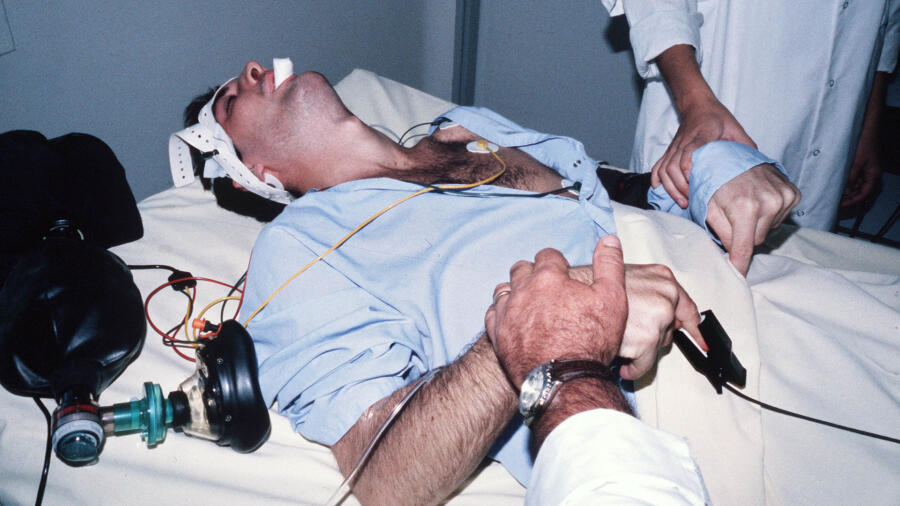For over a century, electricity has been used as the ultimate punishment on criminals who’ve gone violently astray of the law. Soon, it may be used to rehabilitate them.
In July 2018, researchers published a study in the Journal of Neuroscience suggesting that running electrical currents through people’s brains—more specifically, through their dorsolateral prefrontal cortexes (an area of the brain associated with working memory, abstract reasoning and selective attention)—reduces their desire to commit acts of aggression.
Unlike electroconvulsive treatment (commonly known as “electroshock therapy”), this new electrical treatment is mild. The researchers used transcranial direct current stimulation (tDCS)—a marginally invasive procedure in which low-voltage electricity is passed to the brain via a series of electrodes. “It’s like a tingling sensation,” says Adrian Raine, a co-author of the study and a professor of criminology and psychiatry at the University of Pennsylvania. “Or a slight itching.”
The researchers are now conducting a larger “replication study,” and although Raine cautions that’s there’s still a lot of work to be done before the results should be interpreted as certifiable fact, he hopes to see tDCS used one day among “individuals with impulsive aggression who want it changed.”
Depending on your point of view, it could be an exciting advancement toward making the world a safer place…or a terrifying step towards moral dystopia.
How the Study Was Conducted
The team of researchers conducted a double-blind study (where neither the participants nor the researchers know who is receiving a particular treatment) with a group of 81 volunteer participants. Each group was given electrical current to their brain—with the experimental group receiving 20 minutes of continuous electrical current, and the placebo group receiving a half-minute dose.
After the tDCS, the participants were presented with hypothetical scenarios of violence and sexual assault, and asked to rate their chance of committing these acts of aggression on a scale of 1 to 100. The study showed those who received the heavier dose of tDCS indicated a lower interest in committing violence, and had a heightened sense of morality around violence.
The History of Direct Brain Intervention on the Aggressively Violent
According to Hank Greely, a Stanford Law School professor and the director of the Stanford Program in Neuroscience and Society, there were about 60,000 lobotomies in the United States between the 1930s and the 1950s, a time when electroshock therapy was similarly commonplace.
Both procedures fell out of favor in the scientific community with the rise of antipsychotic drugs, then faced wider moral reckoning when the film One Flew Over the Cuckoo’s Nest (1975) brought wide attention to the ramifications of frontal lobotomies and electroshock therapy in insane asylums.
But the invasive surgery and therapy were predominantly used at insane asylums—not prisons—largely to treat mental illness, not fight crime. So there’s scant legal framework from that time to determine what future courts can and can’t do to curb recidivism. “There’s [only] somewhat of a precedent,” says Greely—namely, two federal appeals cases from 1973 (Knecht v. Gillman, Mackey v. Procunier) where prisoners claimed to have had drugs administered against their will as a form of “aversion therapy.”
Some may see a parallel between tTDCS and chemical castration where, contrary to the implication of the name, offenders simply take pills that change their hormone levels and reduces their sex drive. The latter is a procedure that’s been approved by a handful of states, but hasn’t been adjudicated on the federal level. “The constitutional status of this is very unclear,” Greely says.
There have also been cases of “psychosurgeries” conducted for the purposes of reducing criminality abroad, notably in China and Russia. In the early 2000s, both countries started programs to reduce drug addiction through brain surgery. In both cases, the governments reported great success but ultimately abandoned their programs later. The Ministry of Health in China banned the procedure due to a lack of data on long-term outcomes and growing outrage over the ethics of its use; Russia banned it due to patient complaints about side effects.
How tDCS (Theoretically) Works
Research suggests a link between the prefrontal cortex and sociopathic behavior and other forms of violent criminality. Namely, reduced functionality in the prefrontal cortex correlates to some violent crime.
Based on that reasoning, the electrical current treatment would be used to enliven brain function to the prefrontal cortex and thereby better connect it to the rest of the brain, much like jump-starting the dead battery in a car.
As such, Raine says those who compare the new procedure to the lobotomies of the last century are getting things backward. “They cut off that controlling, regulating neural mechanism. What we’re doing is quite the opposite. We’re trying to enhance the part that’s involved with regulation and control.”
The Ethical Implications
The ethics of direct brain interventions are intimately tied to questions of efficacy and harm.
In its heyday, the frontal lobotomy was seen as a miracle cure to several mental disorders, so much so that its inventor, António Egas Moniz, was awarded the Nobel Prize. It was only in the years that followed that its negative effects—specifically the irreversible emotional deadening of the patients—became fully understood.
The efficacy of chemical castration, meanwhile, is likewise debated: It’s not clear whether reducing a sex offender’s libido will stop their criminal behavior.
One issue, says Greely, is criminality is considerably more difficult to pin down than a single medical problem. “Criminality is a complex human trait. It’s not like a reflex; it’s not like being able to hear or smell,” he says. “And complex traits usually don’t have nice, simple answers.”
Still, Raine contends that any qualms people might have about this potential new frontier of crime reduction is ill-placed. “People can feel squeamish about an electrical current… but you would say there’s nothing wrong with giving people cognitive behavioral therapy, and that’s changing their brain… The difference between the two is one is a physical intervention and the other is a social intervention.”
Related Features:
Dogs Behind Bars: What Inmates Get from Training Service Animals


